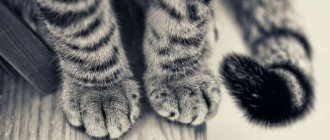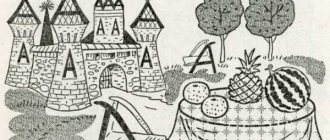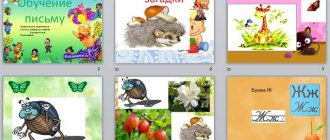Frontal speech therapy lesson in the senior group on the topic “Sound and the letter Sh.” Abstract
Speech therapy session in the senior group.
Sound and letter Sh. Description: This lesson was conducted in a senior speech therapy group. When preparing the lesson, the emphasis was on the development of the phonetic-phonemic aspect of speech in children. This lesson will be useful for speech therapists and preschool teachers. Purpose: To introduce children of senior preschool age to the sound “SH”. Objectives: 1. Teach children to characterize the sound “Ш” according to acoustic and articulatory characteristics.
2. Develop general, fine and articulatory motor skills of children. 3. Develop phonemic processes. 4. Practice analyzing words and sentences. 5. Instill in children self-control over newly introduced sounds. Progress of the lesson
1. Organizational moment Guys, let's greet each other with a song.
Logorhythmic greeting “Hello palms”
2. Announcement of the topic of the lesson.
The speech therapist puts a picture of Snakes on the board.
Who is this?
How does a snake hiss? (sh-sh-sh)
Today we will get acquainted with this sound.
3. Acoustic-articulatory image of sound. Pronunciation of an isolated sound Ш with the connection of oral, tactile-vibrational and acoustic control. Observing the position of articulation in the mirror: the lips are extended forward, the wide tongue is raised to the alveoli and creates a barrier to the air stream that passes through the middle of the tongue, the vocal cords do not vibrate (the neck is silent). The sound Ш is a consonant, dull, always hard, denoted by a blue chip. 4. The connection between sound and letters. Examination of the letter Ш. The letter Ш is like a scallop. Comb the doll, my friend! We put three teeth in a row and connect them at the bottom. 5. Development of phonemic hearing. The speech therapist names correct and incorrect sounding words.
Children should clap their hands when they hear the correct word. Cap, slipper, hat, cap.
Balysh, kids, kavysh, tabysh. Maiba, Kaiba, Thaiba, puck. Takhmats, chess, bakhmats, khammatas. 6. Physical exercise. Performing movements according to the text of the poem.
All the guys stood up together and walked in place. They stretched on their toes and turned to each other. We sat down like springs, and then sat down quietly. 7. Consolidation of sound in syllables. Sound analysis of syllables АШ, ША. The speech therapist lays out diagrams of syllables on the board, and the children say which diagram fits which syllable. 8. Consolidating sounds in words. The speech therapist hangs pictures on the board whose names contain the sound Ш. Children must sort these pictures into 3 groups: the sound Ш at the beginning of the word, in the middle of the word and at the end of the word. After this, the words are divided into syllables. Then the speech therapist, together with the children, conducts a detailed sound analysis of the word “shawl” and lays out a graphic diagram. 9. Fixing sound in sentences. Working on a deformed phrase. Children are asked to make sentences from words. There is porridge on the table. The drivers have a leather cap. 10. Fixing sound in text. Isolating words with the sound Ш from the text. The little animal is jumping - Not a mouth, but a trap. The frog will get both a mosquito and a fly. 11. Summary of the lesson. What sound does a snake make? What sound is this? Name words with the sound Ш at the beginning, in the middle, at the end of the word.
We recommend watching:
Summary of an individual educational activity with a 5-6-year-old pupil for the correction of sound pronunciation. Notes of an educational activity in a senior speech therapy group. Notes of a lesson in a senior speech therapy group. Notes of an individual correctional and developmental speech therapy lesson. Senior group
Similar articles:
Summary of educational activities in the older group of children with severe speech impairments on the topic: “Sounds S - Z”
Summary of educational activities in the senior group of children with severe speech impairments on the topic: “Sounds S - Sh”
Summary of a subgroup GCD to eliminate disturbances in sound pronunciation in children of the older group with severe speech impairments
Summary of educational activities in the senior speech therapy group on the topic “Cossacks and their traditions”
Logorhythmic lesson for children of senior preschool age with special needs on the topic: “What types of transport are there?”
outline of a speech therapy lesson sound and letter [Ш] outline of a speech therapy lesson on the topic
Topic: “Fairytale forest.”
Goal: - consolidate the skills of distinguishing and clearly pronunciating the sound [Ш] - determine the positions of sounds in words; - form word formations of nouns with a diminutive affectionate suffix; - develop phonemic hearing, memory, attention, thinking.
Equipment: pictures, easels, Christmas trees, ball, cubes, envelope, hare.
Progress of the lesson:
1. Organizational moment: Listen to the words: bump, whisper, shorts, noise, closet. What sound do you think is repeated in all words? ([SH]) Correct. Today we will reinforce the sound [Ш]. Sit down, Bunny came to visit us today. And I know the story about the Gardener Bunny.
It happened in the forest. A little hare was galloping through the forest, and leaves were just beginning to appear on the bushes; the forest animals were hungry. And the bunny remembered that people grow their own food and decided to plant a vegetable garden too. He took a shovel and went to the clearing.
Exercise "Scapula"
He's digging and suddenly hears someone hissing: “Hey, little bunny, what are you doing?” — I’m digging a garden to grow food. The snake raised its head, looked around and praised the bunny.
Exercise “Funny Snake”
Suddenly a hedgehog runs past and sees a dried fungus.
Exercise "Mushroom".
He praised the bunny and continued rustling. And then the bear comes, carries a jar of jam, treats the bunny for his work.
Exercise “Delicious jam”.
The bunny digs further and sings songs: “A-o-u-i-y-e.” And in the evening the squirrel jumps, carries a cup to salt the cabbage. Exercise “Cup”.
All summer the bunny took care of the garden, grew so much cabbage that he had to call the horse to take away the harvest. Exercise “Horse”
All the animals were happy, only the snake hissed loudly and angrily, because it doesn’t eat cabbage: sh-sh-sh-sh, and then quietly: sh-sh-sh-sh. The snake crawled away and took the sound [Ш] with it. The bunny was upset, now he became not a bunny, but a bunny. Let's help you find the sound [Ш]. But the snake will give it back only when you complete its tasks. And for this we will go to a fairy forest.
First, let's practice hearing the sound [Ш].1. I will name the words and if you hear [Ш], make noise with the rattle. Take the rattles. Make noise, potatoes, fur coat, bus, chocolate, cheese, cherry, house, shorts.
2. I see that you are ready and we set off on a journey, get on the train and go: Let's go, let's go, let's go. We've arrived. Listen to the noise of the trees and repeat: Shi-sha-shu ash-osh-ush Shta-shto-shtu shka-shki-shku Asha-osho-ushu ishk-ashk-oshk
3. Look, the snake left the ball in the clearing and wants us to play the game “Say the Word.” I say the beginning of the word, and you add the syllable “SHKA”.
We - shka noru - shka Lyagu - shka kvak - shka Matre - shka nevalya - shka Karto - shka Anto - shka Mi - shka bunny - shka
4. Physical exercise: We walked and walked through the forest and found a lot of cones. The children ran further and met a frog. Jumping Frog - Eyes on the top of the head. Hide from the frog, mosquitoes and flies.
5. Look, the Christmas trees are standing without cones, the cones are lying here, but they are not simple, but with pictures. Select pictures that have the sound [Ш] in their titles. And now we need to hang the cones on the Christmas trees: (Ball, scarf, wardrobe, porridge, roof, frog, pencil, reed, finish, chestnut, reel, brooch, tire). - on the first tree there are pictures in which the sound [w] is at the beginning of the word; - on the second tree there are pictures in which the sound [w] is in the middle of the word; - on the third tree there are pictures in which the sound [w] is at the end of the word.
6. But the snake left a letter with a task: Name the picture so that the sound “SH” appears:
House - house Hare-hare Nuts - nuts Peas-peas Rooster - rooster Bread - bread Shek Cow-cow Nest-nestsko Fish-fish
7. The squirrel has a hollow. It’s cozy and warm. In the hollow, a squirrel is leisurely gnawing on delicious nuts. The squirrel ran away and left the nuts, let's give them to the squirrel. To do this, you must remember and name words with the sound “SH”. Say the word and climb to the next branch.
8. We returned the sound [Ш] to the Bunny and he became the Bunny again. He thanks you, but I feel sorry for him because he has nowhere to live. Let's help him build a house. And the walls of the house should be made of pictures with the sound [Ш].
9. Guys, you found the sound [Ш], and there is also the letter [Ш]. What is the difference between a sound and a letter? We hear and speak sounds, we see and write letters. Show the Bunny the letter [Ш]. Place it on a piece of paper.
Well done! You have completed all the tasks and the bunny is happy and the snake praises you, and they have prepared treats for you. What's in my hands? (Bag) And in the bag? (nuts) How many nuts? (six) Take equally. What sound were we looking for today? ([Ш]) What task of the snake do you remember? What game would you like to play again?
Thank you, class is over.
Summary of a speech therapy lesson on the topic “Sound and the letter Sh”
Summary of a speech therapy lesson on the topic “Sound and the letter Sh.”
Target:
consolidate the ability to correctly pronounce the sound [w] in syllables, words, phrases.
Tasks:
Corrective:
breathing development; activation of the articulatory apparatus; development of phonemic perception and hearing; development of HMF and fine motor skills.
Educational:
determine the place of a sound in a word; differentiation of sounds [w - s].
Educational:
nurturing interest in activities.
Methodical techniques:
games with a tiger cub; using exercises with listening and distinguishing the sound of musical instruments; breathing exercises; exercises to automate the sound [w] in syllables, words, phrases; exercise on sound differentiation [w - s]; exercise to determine the place of sound in a word, sound analysis.
Equipment:
Personal Computer; computer speech therapy program “Games for Tigers”; flat figurine “tiger cub”, individual child’s notebook.
Progress of the lesson:
Organizing time.
-Hello, Lera! Today Tiger Cub came to visit us. He invites you to take a fascinating journey through the land of sounds and words. You agree? Sit correctly, comfortably on a chair, keep your back straight. Close your eyes and count to three: one - two - three. (the Tiger Cub figurine disappears, and the Tiger Cub appears on the computer screen).
2. Communicating the topic and setting the goals of the lesson.
- Today we will play with the sound [w] and learn how to pronounce it.
3. Work on phonemic processes.
-Let us now listen to the sound of instruments and learn to determine which instrument sounds. Game "Music".
4. Work on breathing.
-Now let’s learn how to blow correctly! When we blow, we don’t puff out our cheeks. The exhalation can be short or long. Games “Dandelions”, “Boats”, “Kite”.
-The tiger cub praised you.
5. Work on articulation.
-Let's try to pronounce the sound [sh]. When pronouncing this sound, the tongue is at the top and slightly moved back. The lips are slightly rounded, the teeth are close together. Game "Bubbles". Pronouncing the sound sh-sh-sh-sh-sh-sh-sh-sh.
6. Automation of sound in syllables.
-Now try to pronounce the syllable SHA, SHO, SHI, SHU. Games “Fish”, “Cloud”.
7. Automation of sound in words.
-The tiger cub invites you to build a house. To do this, you must rhythmically pronounce small words (noise, shock). Game "House".
8. Differentiation [sh-s].
-The animals have lost their home. Let's help move the animals into their houses. Game "Rest the Animals".
9. Sound analysis [w].
-Now we will try to determine where the sound [w] is hidden in the word (at the beginning, middle, end). Game "Locomotive".
10. Summing up, assessing the child’s activities.
-You did a very good job with Tiger Cub’s tasks. Tell me what sound we practiced today? Well done! You're doing great. Did you enjoy the exciting journey with Tiger Cub? What games did you particularly like? Now close your eyes and count to three. (The computer closes and a flat figure of the Tiger Cub appears.) And the tiger cub has prepared a simple saying for you, which we will repeat with you: A hat and a fur coat - that’s our Mishutka. This is your homework. At home you will learn to pronounce it and learn it by heart. Our lesson is over. Say thank you to Tiger Cub and say goodbye to him and the guests.
Developed by a teacher-speech therapist
Koneva Olga Alexandrovna
Center for Psychological and Pedagogical Rehabilitation and Correction “Dialogue”, Shimanovsk, Amur Region
Stage : Automation of sound in words.
Goals:
1.) Reinforce the correct pronunciation of the sound “Ш” in words;
2.) Practice forming verbs using prefixes; develop fine motor skills;
3.) Develop auditory perception through the game “True - False”, “Agree a Word”, “Catch the Sound”; Develop memory through the game “Day and Night”.
Equipment : mirrors, pictures for articulation gymnastics, cotton balls, miracle tree; candies; subject pictures: jug, car, grandmother, barbell, cat, curtains; soft toys: frog, bear; sheets of paper with a schematic image of a pit, bridge, river, mountain, house (according to the number of children); 2 mugs of red and black (for each child); sound lines; box with pictures: mouse, accordion, pencil, horse, hat, galoshes.
Progress of the lesson
1. Organizational moment
2. Setting goals. Clarification of sound articulation, its isolated pronunciation with subsequent characterization
— Today in class we will continue to work on the correct pronunciation of the sound “Ш”.
— In what position are the organs of articulation when pronouncing the sound “Ш”? (The tongue in the shape of a “cup” is raised up, the lips are in the shape of a “horn”, there is a small gap between the teeth.)
- What kind of air comes out of your mouth when we say the sound “SH”? (Warm.)
— Is the voice motor working? (It doesn’t work, which means the “SH” sound is dull.)
3. Articulation gymnastics
A bear appears under the miracle tree.
- Today I will tell you a story about a little bear.
On a cold autumn evening, the little bear sat down on a tree stump and began to remember the warm summer. How he and his friends - a frog and an elephant - went into the forest (exercise “Smile” - “Proboscis”, alternation). In the forest they picked strawberries, and then they all cooked strawberry jam together (exercise “Tasty Jam”) and drank tea (exercise “Cup”) with pancakes (exercise “Pancake”).
It was good in the summer, but it was already late autumn, the bear did not have time to build a den for himself and there was little snow in the forest, but he really wanted to relax, hiding under the snow.
- Let's help the little bear collect snow. (Cotton balls on strings are distributed, children blow the balls from their palms, and then put them under the tree for a bear.)
- Thank you guys for helping the little bear, let's take him home.
4. Finger gymnastics.
The teacher gives the children sheets of paper on which a river, a bridge, a hole, a mountain, a house are schematically drawn.
— The bear stood up on its hind legs and went home. But he encountered obstacles along the way. (Children use the index and middle fingers of their leading hand to depict a walking bear.)
Speech therapy lesson notes [Sound and letter Ш]
TASKS:
1. Automate the sound [w] in syllables, words, sentences. 2. Isolate sounds from words, divide words into syllables. 3. Phonemic analysis of words like CAT. 4. Introduce children to the letter Ш. 5. Read forward and backward syllables.
EQUIPMENT: object pictures, pencil cases, letters, sticks, toys.
PROGRESS OF THE CLASS.
1. Organizational moment.
The children are sitting in their places.
- Guys, look, guests have come to us. Let's get up, turn to the guests and say hello. — Today in class we will get acquainted with a new sound. But first, let's remember how a sound differs from a letter. (We pronounce and hear sounds, and we write and read letters).
We cannot see the sound, And we cannot pick it up. We can only hear the sound, and also say it.
— What two groups are all sounds divided into? (Sounds are divided into vowels and consonants.)
— How do vowels differ from consonants? (When pronouncing a vowel sound, the air does not encounter obstacles and therefore the sound can be drawn out for a long time. A consonant sound does not stretch because when it is pronounced, the air encounters obstacles).
The vowels are drawn to the ringing song. They may cry and sob. In the dark forest they call and hoot, But they don’t want to whistle and grumble.
And the consonants agree to rustle, whisper, creak, even snort and hiss, but I don’t want to sing to them.
2. Report the topic of the lesson. Characteristics of the sound [w] according to articulatory and acoustic characteristics.
— Now we will talk about a new sound. And music from the cartoon you know and love will help us with this. Children listen to music.
— Who remembered the author of the fairy tale on which this wonderful song was written? (This music is from the cartoon “Gena the Crocodile and His Friends” based on the fairy tale by Eduard Uspensky).
— Guys, name the heroes of the fairy tale “Crocodile Gena and his friends.” (This is Cheburashka, the girl Galya, the lion Chandra, the old woman Shapoklyak, the rat Lariska, etc.).
- Listen to who sings this song (Cheburashka’s song sounds). Look who came to visit us today. The speech therapist puts the Cheburashka toy on the desk.
- Cheburashka came to complain to us about a mischievous old woman who is preventing us from doing good deeds and helping people. Can you guess who it is? (Shapoklyak).
A drawing depicting the old woman Shapoklyak is put on the board.
- Right. Maybe today she will see what we do, such smart and diligent children, and she will also become smarter and kinder. Shall we help her with this?
- Do you know why the old woman is called Shapoklyak? She was named after the ancient headdress she wears.
- So, what is the first sound we hear in the old woman’s name? (This is the sound [sh]).
Articulation of sound (tongue cupped, lips rounded), characteristics (consonant, hard, voiceless).
- This sound has a peculiarity, it is never soft, always hard. Which hero's name has the same sound? (Cheburashka).
- In what part of the word do we hear it? (The sound [sh] is heard in the middle of the word).
3. Automation of the sound [ш] in syllables.
— Cheburashka came to our lesson from afar. He walked through the forest and listened. And the forest rustled: “Ash-osh-ush-ish!” (Cheburashka became wary). What-what-thing-thing! (I got scared.)" But then the leaves whispered: "Shu-shu-shu." And Cheburashka calmed down. What sounds did you hear in the whispering of the leaves? (Sounds [w], [y].) Complete them with the sound [m]. What word did you get? (Noise.) “Scatter” the sounds of the word noise. How many sounds does it have?
4. Phonemic analysis of words.
- Look who Cheburashka met on the way (bear, cat). Phonemic analysis of the words bear, cat.
5. Automation of sound [ш] in words.
“Cheburashka came out of the forest and came to us.
a) Game “Name the picture”. Pictures of various colors are displayed. On the edge of the forest grew... (daisies, lilies of the valley, porridge), on the river... (water lilies, egg capsules). On the bank of the river Cheburashka saw ... (pebbles), on a pine tree - ... (cones), on a hazel tree - ... (nuts). Under the bush there grew... (red flowers). What bird did Cheburashka see on the tree? (Cuckoo.)
b) Game “Add a word”.
The speech therapist speaks on behalf of Cheburashka, and the children help lead the story.
-I was walking through the forest and a wave... (found). Then I went into the forest... (went), into the thicket of the forest... (went) and to the hut... (went), then into the hut... (went), nothing there... (found), then... (went). I ... (approached) to the tree, there I found sweet honey ... (found). Along the path... (went) and to your class... (came).
c) Game: “Lay out the pictures.” Dividing words into syllables.
— Cheburashka walked along the road and saw 3 houses. There are three houses on the board (one-story, two-story and three-story). The children have pictures on the table. Children should arrange their pictures into houses depending on the number of syllables in the word.
6. Physical exercise (carried out on the carpet).
- Listen to the poem and do the actions.
Make a circle! Wider circle! Friend on the right. Friend on the left. We walk in a circle, sing a song. Our group is friendly. We live happily.
Now get your hands ready.
The girls and boys in our group are friends. You and I will make friends with little fingers. One, two, three, four, five Start counting again. One, two, three, four, five We're done counting.
7. Automation of the sound [sh] in sentences . Analysis of the composition of the proposal.
- Now make up a sentence with your own word. The sentence must have five words. Show Cheburashka how we denote the words in the sentence. Proposal analysis.
- Cheburashka wants to play rhyming words with you. Look, he brought you an envelope. “Confused” verses are written here. Listen carefully and correct mistakes (children repeat correct sentences completely).
My friend and I played cups... (checkers). We drank tea from a white checker... (cup). A cone came out of the hole... (mouse). A mouse fell on her... (bump). There were cones sitting under the bush... (mice). There were mice hanging on the pine tree... (cones). A cat was flying in the air... (midge). The midge... (cat) lapped milk. There was a cat on the table... (a bowl). There was a bowl sitting on the floor... (cat).
8. Getting to know the letter Ш : tracing along the contour, typing it with your finger on the table, composing it with sticks.
- Oh, it looks like there’s something else in the envelope. Look, these are letters.
Reading syllables. Rule: the letter Y never comes after the letter Ш.
9. RESULT OF THE LESSON.
— Our guests really enjoyed the activity. Now Old Woman Shapoklyak will no longer misbehave and, like you, will go to school. Let's remember what we talked about today? Name words with the sound [sh]. The lesson is over.
Prepared and conducted by teacher-speech therapist K.N. Martyanova.
- Summary of frontal correctional speech therapy classes with students in grades 6-7
- Structure of daily speech therapy sessions
- Structure of an open speech therapy session
- Individual lesson on sound automation [L] in syllables, words, phrases, connected text [Differentiation of sounds L – R]
( 12 liked, average score: 4.75 out of 5)
Loading...





